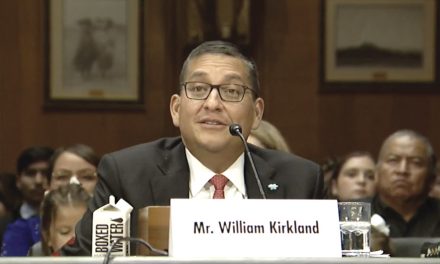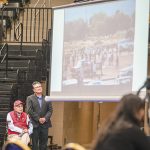
Letters: Student attends White House Tribal Youth Gathering

I had the most important conference at the first ever White House Tribal Youth Gathering gear me to focus on issues young Navajo people face. Along with the UNITY Conference that showed me there are other tribes that face the same problems and looking for solutions that will address those problems. So many great guest speakers came and talked to us and have us a message to send back home “Move Your Generation.” That I think got discussions, debates and woke a lot of youth nationwide to play a role in their communities. I applaud the staff, EC members, and volunteers for making this happen for so many youth in changing their tribes, communities, or lives.
I plan to help my Navajo people by gathering youth to start a Navajo Nation Youth Council, because so many youth are being left out of the picture. Being the student body president at Navajo Preparatory School, I plan to start there and work across the Navajo Nation. It is time for the youth of our nation to be heard. Whether it’s at home, in their chapters, tribal council, or straight to the president’s office.
So again, Ahé’hee UNITY, the White House and other sponsors for making this happen. It’s time for us to get to work now.
Triston Black
Student Senate President
Navajo Preparatory School
Farmington, N.M.
(Hometown: Tsaile, Ariz.)
Skiing adventure v. Sacredness
This letter references your story “Beyond Faith” (June 25, 2015), which concerns our Diné faith and Dook’o’sliid and all things sacred.
— Spirituality, so widely misunderstood, is the state of being that can only be achieved when we are obedient to the laws of the holy people, the laws of nature, the laws that are common laws, and the laws that are civil. There is no way for us to change the laws of the holy beings or the laws of nature. If we tamper with the common or civil laws, we cause chaos and suffering. Spirituality is therefore necessary as it allows learning and understanding beyond the five physical senses.
— Mountains are considered a symbol of all life and their existence tells the story of the previous worlds and the journey into the final last world, which is the Fourth World. We are still in the yellow, Third World, and we exist today in a three dimensional environment. We still exist under the glow of the yellow sun. We have to still journey the yellow Corn Pollen Path into the Fourth World.
Mountains have had their journey from the First World the same as all beings. Mountains came into existence as dark volcanic rock, or as dark and gray granite rock. They are symbolic of the black and dark of First World.
As time progressed, the mountains produced vegetation of every kind. Vegetation is green and makes the mountains appear blue from a distance. They became symbolic of the Second or Blue World. In their season the vegetation on the mountains turns yellow and gold and the mountain then becomes symbolic of the Third or Yellow World.
As the seasons progress, the snow falls and covers the mountains and the mountains become white, symbolic of the White or Fourth World. That by the way is the meaning of Dook’o’oosliid as the snow provided by the holy people reflect all the colors of the rainbow as they symbolize the promise of the glittering Fourth World yet to come.
The mountains reach into the sky and bring down the rain, snow and water that is the lifeblood of Mother Earth. From the water comes our food and medicine, and provides for all our physical and spiritual needs.
— At the mountaintop there is very little soil. We have to search and when we find some, it is our treasure. We share the soil with our loved ones and we use it as our personal sacred offering. It is the closest evidence in physical form of “honor” to self and sacredness. It is something that we gain for ourselves and no one can ever take that from us. It is what makes us Diné.
Mountains in all the cultures of history have had their place of importance: Mount Sinai, Mount Olympus, Mount of Olives, Mount Nebo to name just a few. From those mountains have come the laws of God or the gods of human kind.
When danger threatens, there is always safety in the mountains. As Diné we know that the mountains surround us to protect us. That is why we are called U-tah-hii. The mountains are where we commune with the holy people by making our altars of sacred stone offerings. It is the place where we quite literally make our highest form of worship to our holiest of beings.
To spray Dook’o’oosliid with wastewater to make snow is motivated by nothing more than greed. Out of a thousand people there are perhaps 10 who enjoy a skiing vacation, an event that would last maybe a few days in their lives.
How would it be if the other believers of the world had to use wastewater in their ceremonial washings, baptisms, and their use of sacred waters — even taking wastewater into a chapel, cathedral, synagogue, or mosque?
I am sure that would be considered sacrilegious and offensive to the worshipers. Those settings are no different than spraying a place of worship, Dook’o’oosliid, with wastewater.
Mountains such as Dook’o’oosliid have been held sacred for thousands of years by Native people. The Diné will continue to respect their sacredness. If you believe a place for a skiing adventure is more important than sacredness, then you mock holiness, God and all things sacred.
Wally Brown
Page, Ariz.
‘Women can lead this great Nation’
In the spring of 2010, I had the privilege of hearing Jennifer Nez Denetdale speak — She discussed the powerful effects that colonialism has had on the Navajo Nation, in particular, on gender and the role of women in the Navajo Nation political process.
— To begin, where does the “traditional” view that women should not be leaders come from? How did this notion that women leadership, at the highest levels, is wrong and detrimental to the societal and political values of the Navajo Nation come into existence?
Dr. Denetdale makes the case that colonialism, under the guise of western patriarchy, has usurped and supplanted the traditional leadership role that Navajo women enjoyed historically.
— It is common knowledge that our mothers give us life, nourish us both temporally and spiritually and instill within us our values and morals. Have we come to a point in our nation today where politically the essence and teachings of our Navajo mothers is rendered invisible? (Jennifer Nez Denetdale, “Chairmen, Presidents, and Princesses, The Navajo Nation, Gender, and the Politics of Tradition”).
— It is ironic and puzzling at times when Navajos of today refer to esoteric “traditional concepts” that women should not lead, yet they never fully offer up a satisfactory explanation that is based in fact. The answer is usually rhetorical in nature and framed thusly “it is tradition.” Whose tradition, exactly?
My own traditions, that I have learned, have been taught and built up, over time, through my mother.
— My mother rose up from humble beginnings, educated in a reservation military style boarding school, where she was hit with a wooden paddle for speaking her language. When I was just a very young girl I remember growing up, for a part of my life, in a dirt floor hogan. We used kerosene to light our lamps and we hauled our water from the local community well. To wash up my mother sometimes took us to the local post office where my sister and I showered under the hand pumps. When we had no food or money, which was a great deal of the time, my mother cooked up a miracle and filled up our bellies so that we did not go to bed hungry. When it came time for me to enter into formal schooling my mom scrimped and saved to provide clothing and school supplies for my sister and me.
My mother never gave up on us. She is the first person in our family to graduate with a bachelor’s degree. As an undergraduate student, I was having a difficult time coping with the consequences of the life choices that I was making. In desperation, I wrote a letter to my mother. She wrote back to me and said, “My child, experience is your best teacher.” At the time I did not understand the meaning behind her words. But as I have grown older, I have come to hold this teaching close to my heart. My mother has led me by example. Because of her example, I too attained my bachelors and masters, and I am working on another degree. I say that, not to boast, but to point to the good example that my mother has been to me to the values that she has instilled in me. To me my mother is strength, endurance and determination personified. By example, my mother continues to teach me that leadership is not a gender specific activity as she has been reelected to political office as a chapter official, twice. From her, I have learned that, without regard to gender, women can and do lead.
In 2015 we have never had a Navajo Nation female president. Currently we have only one female Navajo Nation Council Delegate, Amber Kanazbah Crotty, who is doing an amazing job advocating for the nation.
— It is my personal belief that women can lead this great nation as council delegates and as president. Our Navajo women holding political office will only serve to strengthen our great nation.
Sharon Jackson
Eastern Agency Commissioner
Navajo Nation Women’s Commission
Window Rock, Ariz.
Pilgrimage heals, fills you with hope and joy
Every person should undertake a pilgrimage to some sacred destination at least once in their lifetime. A pilgrimage means different things to each individual and the meaning of a pilgrimage is up to the level of importance one attaches to the experience. It can be done on foot, car, train, or airplane. Either way, it is a sacred experience.
My family and I undertook such an experience in early July by going south to the border area of Laredo, Texas, to the sacred Peyote Gardens to the get the holy sacrament peyote. The peyote’s lands are mostly in Mexico with the outer perimeters reaching into Texas in Starr, Zapata and Jim Hogg Counties.
Ancient legend says that the magical blue deer descended from the Morning Star and this deer became the medicine that we now ceremonially consume. The peyote lands are in the shape of a deer, with the heart being in Mexico, in Wirikuta, and the outer reaches, the antlers, being in Texas.
Our people, the Cree of Saskatchewan, are far from these southern lands and some of our people say that the peyote does not belong with our people as it is not from “here”, meaning I assume, within the borders of Saskatchewan and Canada, borders which were not here during the time of creation. Many of our people sometimes forget that we live on an island, Ministik, and that our Elder Brother sent a crow, and some say a wolf, to circle the land, and these beings, upon their return many moons later said that this land was big enough for the indigenous people of this land. This includes the sacred peyote lands as it is part of Minisik, this island. Some indigenous people call this island, Turtle Island. This land has no borders and boundaries and is there for the people to travel, partake in ceremonies, and find good medicine for their spirits and bodies.
The Huichol People of Mexico go on an annual pilgrimage to collect peyote in Wirikuta, their name for the sacred peyote lands. They structure this pilgrimage as a sacred hunt. We structured ours as a war party with prayers and offerings made until we achieved our goal, that being, the sacred medicine. When and if we achieved our goals we would host a ceremony to celebrate our victory and to give thanks and tell the listeners of our travels and adventures, just as the warriors of old would recount tales of their exploits.
It took us four days to arrive at the border city of Laredo. On the fourth day we encountered the peyote. It took us four days to arrive back at home. For our people, four is a sacred number and many sacred activities are structured around this number. The day we arrived at the Peyote Gardens, we were blessed with a full moon and Jupiter and Venus had become one holy star.
Tobacco leads the way in all sacred action, as it was the first plant to grow on Mother Earth. Our first tobacco was placed upon our departure from our reservation, Poundmaker, for success in crossing the border. Our second was placed upon crossing at the Missouri River, for a safe journey to the sacred lands.
The third tobacco was smoked once we had successfully been given the medicine and the smoking was done in the magical and silent overgrown yard of Senora Cardenas, deceased, a long time supporter of the Native American Church in Mirando City, Texas. A moist wind from the Gulf of Mexico blew the smoke of our prayers into the sky over the Valley of the Peyote, where this medicine grew. Senora Cardenas had set aside this lot as a site of prayers and ceremonies for Native American Church members who come to this valley to get peyote. The fourth tobacco was given during the thank you ceremony held at our home in Poundmaker with roadman Elvis Curley conducting the services.
A pilgrimage changes the pilgrim for the good and only good things come from such a journey. It was an honor to undertake this journey, following in the footsteps of so many others who journeyed south to this healing land, where the land seems to envelop you in a warm embrace, healing you of your stresses and sorrows and in return to fill you with joy and hope.
Floyd Favel
Saskatchewan, Canada
To read the full article, pick up your copy of the Navajo Times at your nearest newsstand Thursday mornings!
Are you a digital subscriber? Read the most recent three weeks of stories by logging in to your online account.








 Highway 264,
Highway 264, I-40, WB @ Winslow
I-40, WB @ Winslow